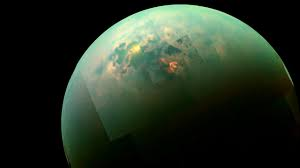Moon-in-a-jar re-creates the misty atmosphere of Titan, Saturn's biggest moon.
- Sri Sairam Gautam B
- Aug 29, 2021
- 4 min read
Scientists have recreated the unique chemical conditions discovered on Titan, Saturn's greatest moon, in tiny glass cylinders here on Earth, and the experiment has revealed previously unknown characteristics of the mineral composition of the moon.

Titan is the second most important moon in the world, behind Jupiter's Ganymede. The yellow mist is about minus 290ºC (minus 180ºC). Below the atmosphere, lakes, seas, and rivers of liquid methane and ethane cover the frozen crust of Titan, especially near the poles. And like liquid water on Earth, these natural gases are part of a cycle in which they evaporate, form clouds, and then rain on the surface of the moon.
Titan's dense atmosphere, surface liquid, and seasonal weather cycles make the frigid moon somewhat similar to Earth, and like our planet, the moon is known to have organic molecules that contain carbon, hydrogen, and oxygen, according to NASA. Because of this organic chemistry taking place on Titan, scientists think the moon could serve as a massive laboratory to study chemical reactions that occurred on Earth before the emergence of life on the planet.
But only one spacecraft, Cassini, has looked at Saturn and its moons in detail, making it difficult to search Earth for the wacky chemistry found on Titan. So lately a team of scientists has undertaken to simulate Titan in a test tube.

The team initially placed liquid water in small glass cylinders and lowered the temperature to conditions similar to those of Titan, the researchers said in a press release. That water froze to mimic Titan's frozen rind. The team then injected ethane into the tube, which became liquid like the lakes at the surface of Titan. Finally, they added nitrogen to stand in for Titan's atmosphere and then varied the temperature of the tube ever so slightly, to simulate the variations in temperature on Titan's surface and in different layers of its atmosphere.
In their recent study, submitted on Thursday (August. 26) at the American Chemical Society's fall meeting, the team then added two compounds, known as acetonitrile (ACN) and propionitrile (PCN). Data from the Cassini mission suggest that these compounds are abundant on Titan, principal investigator Tomče Runčevski, an assistant professor in the Department of Chemistry at Southern Methodist University in Dallas, told Live Science.
Most previous studies examined these two compounds separately, in their pure forms, but Runčevski's team wanted to see what would occur when the compounds mixed and mingled, as they might on Titan. As opposed to working with each compound separately, "if you mix them... there might be a completely different outcome in structure, so how the molecules will organize, and how the molecules will crystallize," or phrase into a solid form, Runčevski said.

And the team found that when both are present under conditions similar to those of Titan, ACN and PCNs behave quite differently than either of the individual compounds. Namely, the temperatures at which the compounds melted or crystallized changed dramatically, on the order of tens of kelvin (hundreds of degrees Fahrenheit or Celsius).
These melting and crystallizing points would be relevant to the hazy yellow atmosphere of Titan. The various layers of the atmosphere differ in temperature depending on their altitude above the moon's surface, so to understand how chemicals behave throughout the haze, the new study suggests that these temperature variations need to be taken into account, Runčevski said.
Furthermore, the team discovered that when ACN and PCN crystallize, they adopt different crystalline structures depending on whether they are alone or in the presence of the other compound. Crystals are formed when individual molecules within a compound engage in a highly organized structure. Although the building blocks of this structure—the molecules—remain the same, depending on factors such as temperature, they may end up assembling in slightly different configurations, said Dr. Runcevski.

These variations in the crystalline structure are known as "polymorphic," and when on their own, ACN and PCN adopt a polymorphic at elevated temperatures and another at low temperatures. But "what we notice is that if we have a mix, the stability of high temperature and low temperature [polymorphs] can be, in one direction, switched," Runcevski said.
These fine details of when and how the compounds achieve a stabilized structure "can really change our understanding of what kind of minerals we might encounter on Titan," in terms of what polymorphs they likely adopt on the moon, he said. This in turn may shape what chemical reactions occur between them and other compounds on Titan.
The new study is limited in that it doesn't account for all of the chemicals present on Titan, and so can capture only a simplified picture of what actually happens on the moon, Runčevski said.
"It's important for us as scientists on Earth ... to create these models with increasing complexity, and one day to reach models that are really significant and can really help us further understand the surface of Titan," he said.

NASA's Dragonfly mission, scheduled for launch in 2026 and arriving at Saturn in 2034, could provide more information about Titan's mineral composition. However, Runčevski suspects that the crystals his team has observed likely form around the edge of Titan's lakes, cropping up as the liquid ethane in the lakes evaporates and leaves those compounds behind the shoreline. At this point, it's unclear whether the Dragonfly mission might focus on this specific aspect of the Titanian environment, but "nonetheless, [the mission] is super exciting, and we will learn so much more about Titan," he said.




Comments